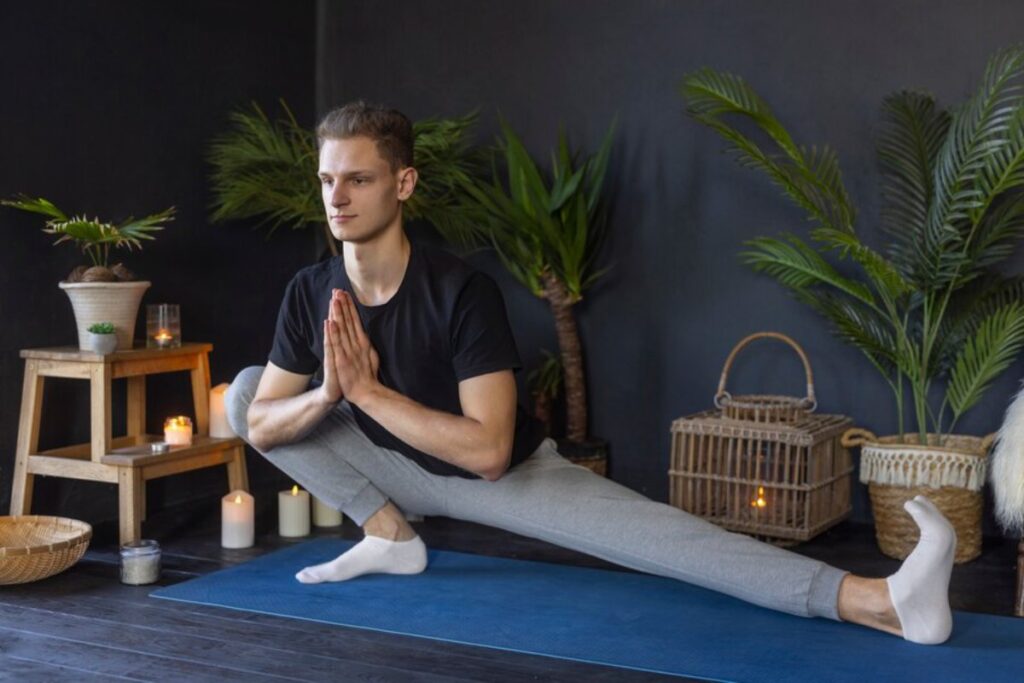The Yoga Blogs

Creating a Daily Yoga Routine for Mental Sharpness
Do you feel foggy by mid-morning or lose focus by 3 p.m.? You’re not alone. In our fast-paced world, mental sharpness can feel out of reach. Many turn to coffee or hacks to stay alert.
But there’s a gentler way to sharpen your mind: a daily yoga routine.
Yoga isn’t just about flexibility; it’s a lifestyle. It blends ancient wisdom with modern science to help you feel more alert, calm, and focused. In just a few minutes of movement, breathwork, and stillness, you can reset and refocus your brain and body. This helps you tackle any challenges that come your way.
In this guide, you will learn to create a daily yoga routine. This routine will help improve mental clarity, boost your brainpower, and bring calm to a hectic world.
Why Yoga Supports Mental Sharpness
The Science Behind the Calm
Let’s explore what happens during yoga. It combines three key elements:
- Movement: Boosts circulation and brain oxygenation.
- Breath control (pranayama): Regulates the nervous system.
- Mindfulness: Quietens mental chatter.
These elements boost the parasympathetic nervous system. They also reduce cortisol, the stress hormone, and enhance attention span and memory. A 2021 study in Frontiers in Human Neuroscience showed that doing yoga often boosts executive function and working memory. These skills are key for staying mentally sharp.
In short, yoga helps your brain function better, not just during practice, but all day long.
From Reactive to Responsive
If your nervous system stays in “fight or flight,” clear thinking is tough. Decisions become reactive, and focus fades. A daily yoga routine trains your body to return to a calm, alert state.
It’s like tuning an instrument. Yoga tunes your mind for life.
Structuring Your Daily Yoga Routine
Building a consistent practice doesn’t mean waking up at 5 a.m. or doing complex poses.
Focus on a routine that’s:
- Manageable: Start with 10–20 minutes.
- Enjoyable: Make it something you want to do.
- Effective: Target mental clarity, not just physical strength.
Here’s how to do it.
Part 1: Morning Movement for Clarity (10–15 minutes)
Your morning sets the day’s tone. Instead of checking your phone first, give yourself the gift of intentional movement to wake your body and mind.

Simple Morning Yoga Flow
Try this 10–15-minute sequence:
- Seated Breathing (2 mins): Sit comfortably. Inhale deeply through the nose for 4 counts, exhale for 6. Repeat.
Why: Regulates your breath and signals safety to your nervous system.
- Cat-Cow (2 mins): Flow between spinal flexion and extension.
Why: Increases blood flow and activates the spine and brain.
- Downward Dog (1 min): Hold or pedal the legs.
Why: Stimulates circulation and stretches the whole body.
- Sun Salutations (5 mins): Flow through 2–3 gentle rounds.
Why: Warms up the body, builds energy, and improves focus.
- Standing Forward Fold (1 min): Let your head hang and focus on your breath.
Why: Calms the mind and stretches the spine and hamstrings.
- Seated Twist (1 min each side): Gently twist from the base of the spine.
Why: Encourages digestion and clarity.
Optional Add-ons:
- Affirmation practice: End by repeating a grounding phrase like “I am focused and calm.”
- Cold water splash or shower: Boosts alertness and energises the nervous system.
Part 2: Midday Reset (5–10 minutes)
As the day goes on, energy dips. Instead of caffeine, try a midday yoga micro-practice to reboot your brain.
Midday Reset Routine:
- Standing Forward Fold (Uttanasana) – 1 min: Shake out your arms and neck.
Why: Reverses blood flow and calms the mind.
- Chair Twist (at your desk) – 1 min per side: Stay seated, twist gently, using the chair for support.
Why: Improves posture and releases tension.
- Eagle Arms Stretch – 1 min each side: Cross arms and lift elbows.
Why: Opens the upper back and shoulders.
- Box Breathing (2 mins): Inhale for 4, hold for 4, exhale for 4, hold for 4.
Why: Lowers stress and improves cognitive function.
Bonus tip: Step outside for a few minutes of natural light. It enhances mood and alertness.
Part 3: Evening Unwind and Clarity (10–15 minutes)
Your evening yoga should feel like a gentle exhale. It’s time to release the day’s mental clutter and prepare for rest.
Calming Evening Routine:
- Legs-Up-the-Wall (Viparita Karani) – 5 mins: Lie on your back with legs up a wall.
Why: Soothes the nervous system and improves circulation.
- Reclining Twist (Supta Matsyendrasana) – 2 mins each side: Gently twist with arms extended.
Why: Releases tension and emotional residue.
- Butterfly Pose (Baddha Konasana) – 2–3 mins: Sit with soles of feet together and fold forward.
Why: Opens hips and encourages introspection.
- Savasana with Guided Meditation – 5 mins: Lie flat, soften your breath, and listen to calming guidance.
Why: Helps integrate your day and quiet the mind.
Making It a Habit: The Yoga Lifestyle Approach
Yoga isn’t just what you do on the mat; it’s how you live every day. A daily routine becomes powerful when woven into a yoga lifestyle.

1. Sleep and Wake Cycles
Yoga philosophy encourages aligning with natural rhythms (circadian cycles). Aim to:
- Sleep by 10:30 p.m.
- Wake by 6:00–7:00 a.m.
- Avoid screens an hour before bed.
Why it matters: A regular sleep cycle enhances memory, concentration, and mood.
2. Mindful Eating
Practice “yogic eating”:
- Eat in silence or with full attention.
- Choose whole, seasonal foods.
- Avoid eating on the go.
Impact on clarity: Gut health is closely linked to mental focus and emotional balance.
3. Mental Hygiene
Daily mental decluttering is as important as physical care.
- Keep a journal: Reflect on thoughts, feelings, and gratitude.
- Limit media noise: Curate what you consume.
- Practice kindness: Towards others and yourself.
This creates mental space — fertile ground for focus and insight.
A Personal Story: From Scattered to Steady
A few years ago, I juggled work, caregiving, and digital noise. My mind felt foggy most days. I stumbled into yoga, joining a morning class nearby.
What I didn’t expect was the mental transformation. My thoughts slowed. I could concentrate better. I felt more centred. Eventually, I brought the practice home — 15 minutes each morning, a short walk at lunch, and 10 minutes before bed.
Now, I cultivate clarity instead of chasing it. Yoga changed how I move and how I live.
What If You’re New to Yoga?
That’s perfectly fine — and often, better. You’re starting with fresh curiosity.
Here’s how to ease in:
- Start small: Even 5 minutes counts.
- Use resources: Try beginner-friendly YouTube channels like Yoga with Adriene or apps like Insight Timer.
- Track your focus: Notice how you feel before and after each session — this builds awareness and motivation.
Most importantly, be patient. Mental sharpness comes from consistency, not complexity.
A Clearer Mind Starts with a Grounded Body
You don’t need a guru or a studio membership to feel clear-headed. All you need is a few minutes each day, a willingness to turn inward, and the intention to move with awareness.
Yoga isn’t about touching your toes — it’s about creating space in your body, breath, and mind. A daily routine boosts physical health and becomes a ritual of returning to yourself.
So here’s your invitation: Pick one part of the routine — morning, midday, or evening — and start today. Notice how it shifts your mind. Build slowly. Make it yours. What does mental sharpness mean to you? Share your story in the comments. Pass this guide to someone who needs help. Also, subscribe for more useful wellness tools that work.
Because the clearest mind is the one that’s anchored, present, and breathing — just like you.









